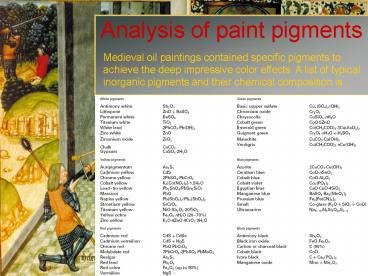Analysis of paint pigments - PowerPoint PPT Presentation
1 / 17
Title:
Analysis of paint pigments
Description:
Analysis of paint pigments – PowerPoint PPT presentation
Number of Views:997
Avg rating:3.0/5.0
Title: Analysis of paint pigments
1
Analysis of paint pigments
Medieval oil paintings contained specific
pigments to achieve the deep impressive color
effects. A list of typical inorganic pigments
and their chemical composition is
2
Fake or Forgery?
The art market is flooded with fake paintings of
20th century artists such as ... Matisse,
Modigliani, Picasso ...
X-ray spectrum indicated the use of cerulean
blue CoOn SnO2 a pigment Modigliani did not use
in any other of his paintings ?forgery?
3
Breviarium van den Bergh
- Breviarium Van den Bergh
- has been illuminated 1510
- by three different artists
- Simon Bening,
- Gerard Horenbout,
- Jan Provoost.
- Comparison of color content
- lead to identification of
- the artist responsible for
- each illumination.
- Comparison of
- dark green
- and light green
R. Klockenkämper, A. Von Bohlen, L. Moens, X-Ray
Spectrometry 29 (2000) 119
4
Different ways to paint green
Jan Provoost painted light green with a mixture
of blue (azurite), white lead, and yellow, all
other samples contained green copper pigments.
For dark green sample again close similarity
between both samples except Pb. Sample from
different miniature contained large Ca component
and less As.
5
Discovery Analysis of Medieval Scriptures
6
The content of ink
FeSO4 gallotannic acid
Ink preparation was an extremely important and
difficult chemical technique. Ink had to maintain
color and stability with time.
15th century manuscript by Raphael de
Mercatellis (1437-1508)
Ferro-gallus ink prepared with an addition of
tin and iron. The recipe allows the dating of
the manuscript.
7
Raphael de Mercatellis
The relative high Fe, Zn content is
characteristic for Mercatellis and allows for a
unique identification of his manuscripts. In
addition the analysis shows that vermilion, HgS,
is not part of the red ink composition.
8
The K-transition in iron-gallus ink
The observed x-ray spectrum lines correspond to
the energy of K-transitions. Calculate the
difference between the characteristic X-ray
transitions for iron and zinc and compare it with
the previous spectrum.
keV
keV
9
The Brittleness of old Documents
10
Authenticity of iridescent Art Nouveau Glass Ware
Tiffany Glass, USA Loetz Glass, Austria Strini
Art Grass, USA Jack Ink Glass, Austria
Iridescence is optical effect of light
dispersion, interference and diffraction when
viewing object from different angles.
Thin SnO2 layer increases iridescence effect
D. Jembrih et al., Nucl. Instr. Meth. B181 (2001)
698-702
11
Statistical Analysis for Comparison
Bulk and surface analysis of K? lines from Mg, K,
Si, Ag, Zn, Se, and L? lines from Pb with
correlation of intensity.
X-ray analysis of SnO2 layer
D. Jembrih-Simbürger et al., Nucl. Instr. Meth.
B226 (2004) 119-125
12
X-ray Fluorescence of Cast Bronzefor Restoration
A Renaissance masterpiece, Benvenuto Cellinis
Perseus (1545) holding the head of Medusa", a
work (first suggested by Duke Cosimo I de Medici)
now in the Loggia dei Lanzi at Florence. The
casting of this bronze group caused Cellini much
trouble and anxiety, but it was hailed as a
masterpiece as soon as it was completed. Because
of damage due to air pollution the bronze figure
was restored in 1996 2000.
13
Cellinis Perseus
14
Absorption in Patina
http//www.csrri.iit.edu/mucal.html
For Cu x-rays, Ex8.2 keV µ469 cm-1 For Sn
x-rays, Ex25.2 keV µ59.7 cm-1
15
Details in alloy composition
Cu-Au composition
Bronze Cu-Sn composition
16
Advanced Techniques in XRF
Laser guidance poly-capillary optics spatial
resolution 100 ?m lateral resolution
17
Summary X-Ray Fluorescence
X-ray fluorescence has a wide range of
application in art and archaeology. It is
superior to radiography since it allows to
determine the chemical constituency of
archaeological artifacts or art samples in a
nondestructive manner. This method provides
opportunities of analysis beyond the absorption
method of X-ray radiography. The method is based
on X-ray induced emission of characteristic X-ray
radiation from the sample material. Typically
only medium or heavy mass elements can be
detected by measuring either the characteristic
energies of the K-transitions for low Z
Elements - or L-transitions - for large Z
elements - with Si(Li) detectors or crystal
diffraction gratings.































